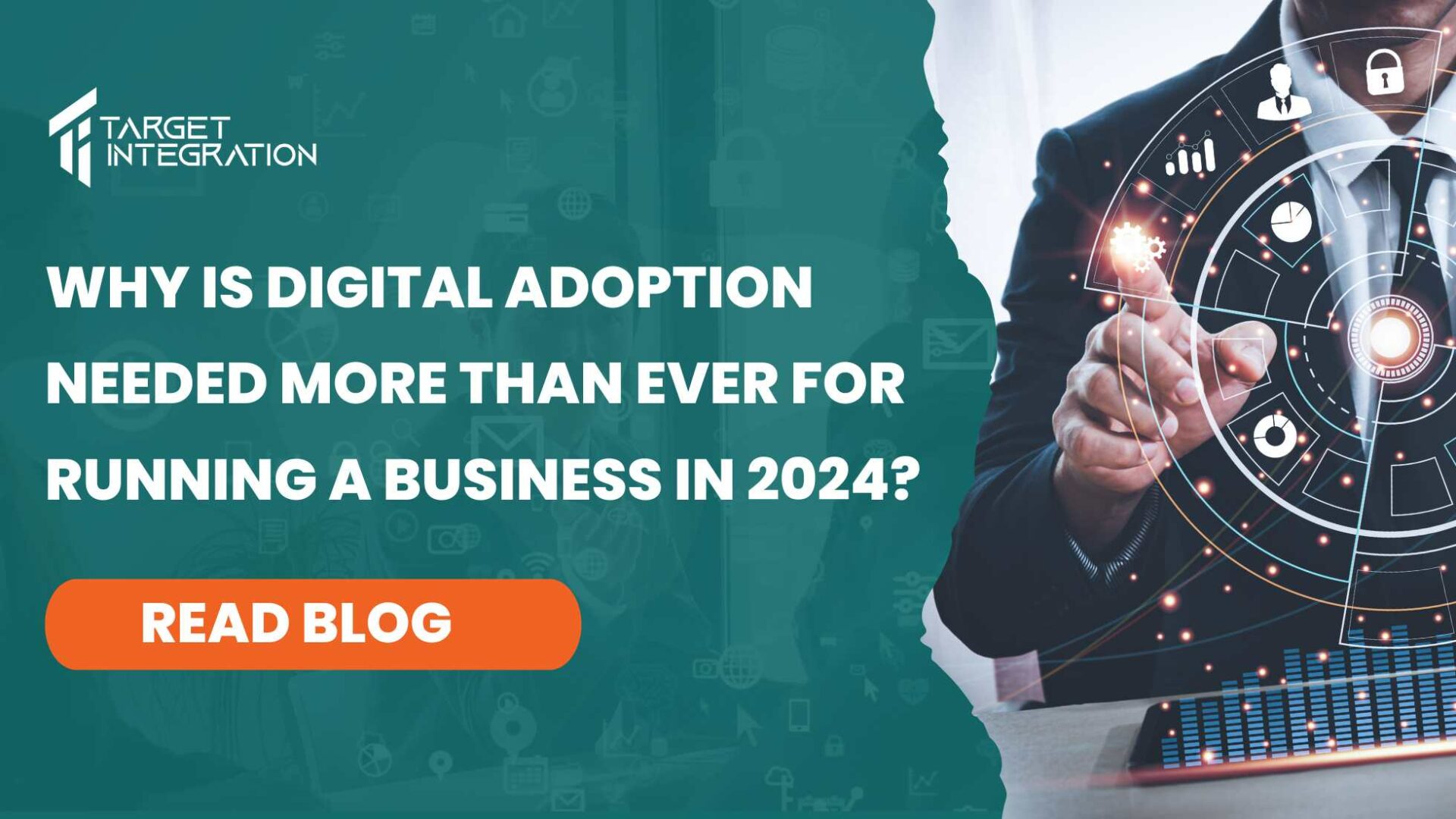Digital adoption is beneficial across the board, but it becomes especially vital for businesses that focus on digital solutions or technology. It’s likely that we can all concur on the significance of user experience in determining the value of your products or services. Furthermore, user experience plays a pivotal role in your employees’ productivity, which in turn affects your overall business performance.
It’s often said that the quality of a business is a direct reflection of its people. However, the influence of individuals is contingent on the tools at their disposal, and in today’s world, the majority of these tools are digital.

Given the constant evolution of technology, ensuring effective adoption of digital tools within your business is paramount. This is at the core of what business adoption truly means. By employing a strategic, user-centric approach, Digital Adoption Platforms (DAPs) can serve as a valuable resource for rapidly integrating digital tools into your operations.
In the absence of a comprehensive digital adoption solution, a company is unable to fully leverage the potential of new technology. In the following discussion, we will explore the advantages of digital adoption and elucidate why it stands as the most critical business process for the growth of digital companies.
Consider this as your comprehensive guide to achieving complete digital adoption.
What Is Digital Adoption in Business?
You’ve likely encountered the term “adoption” within the realm of business, but what does it entail? Adoption represents the process of involving employees or customers in a new way of conducting activities.
Digital adoption, on the other hand, pertains to the training and support provided to existing employees to embrace and effectively utilize digital tools. The concept of digital adoption encompasses numerous factors.

Defining Business Adoption
In the context of today’s digital work environment, discussions around business adoption primarily revolve around digital adoption. In this context, the most elucidating definition of business adoption is as follows:
It entails attaining a state in which anyone utilizing digital tools for business purposes is utilizing them “as intended” and to their fullest potential.
Common Processes for Embracing Digital Technologies
- Technology Integration: This involves adopting and implementing new software, hardware, or other technological solutions. Software integration occurs at various levels within a business and is highly advantageous.
- Leveraging Digital Tools: Embracing new digital technology and utilizing it to its maximum potential, thereby optimizing software return on investment and enhancing user productivity.
- Process Incorporation: The process of adopting and integrating new business practices and procedures.
- Embracing Novel Business Models: This includes the transition to new business models, revenue strategies, strategic frameworks, and more.
It’s important to recognize that every business transformation initiative encounters challenges related to digital adoption. It’s worth noting that not all digital adoption processes achieve success, as many may fall short. Effectively managing, supervising, and optimizing adoption procedures can profoundly influence the outcome of a project.
Understanding the Distinction Between Digital Adoption and Digital Transformation
While both these processes are closely interconnected, it’s crucial to differentiate between each concept.
Digital transformation (DX) pertains to the use of digital technology to enhance organizational processes. A successful transformation strategy results in improved company processes, heightened productivity, and the delivery of superior products to customers. Notably, digital adoption plays a pivotal role within this context.
Many organizations believe that incorporating more technology equates to increased efficiency. However, they often fall short in fully harnessing their digital assets. Consider an organization seeking to automate internal processes such as inventory management or recruitment. Appropriate software applications have the potential to enhance efficiency, but only when employees possess the knowledge and skills to effectively utilize them.
Digital adoption (DA) focuses on how a company actively involves its employees in the transformation process. It entails providing training to employees regarding software utilization. Executives should give precedence to adoption if they aim to extract maximum value from their investments in software.
Digital adoption seeks to cultivate a company culture that embraces digital technologies. A successful adoption strategy can bring about a shift in attitudes towards technology within the organization.

Advantages of Embracing Digital Adoption
- Cost Reduction: The implementation of new technology leads to more streamlined business processes, resulting in reduced project expenses.
- Enhanced Project Timelines: Efficient management of adoption expedites project completion.
- Mitigated Employee Resistance: Employees often exhibit reluctance towards change, but influential management leaders can mitigate or overcome this resistance, promoting digital adoption.
- Elevated Productivity and Performance: Proper management ensures that project participants perform at their best, achieving higher levels of productivity.
- Supplementary Gains: Effective adoption management can yield additional benefits beyond the primary project goal.
- Improved Project Outcomes: Ultimately, superior project management tends to lead to better project results.
Cost-conscious businesses should prioritize understanding how to navigate these adoption practices. Many business leaders view technology investments as risky due to a lack of confidence in their organization’s business strategy.
While comprehending how to enhance the digital adoption process is pivotal for gaining executive support, it represents just one facet of the solution.
Enhancing and Managing Your Digital Adoption Approach
Regardless of whether you’re implementing a new SaaS platform or introducing a fresh workflow process, it’s imperative to have a robust digital adoption plan in place. There are several tried-and-true strategies that business leaders employ to ensure employees are fully engaged in this process.
Common Strategies to Enhance Digital Adoption
- Change Management Strategy: Organizational change can be intricate and challenging, so every adoption process should incorporate methods for facilitating change. This entails effective user onboarding, ongoing training, and support.
- Digital Transformation Strategy: Embarking on the journey to become a fully digital business necessitates a well-crafted strategy. Each business should develop a distinctive digital adoption strategy tailored to its specific goals.
- Digital Adoption Strategy: Achieving successful adoption is the key to maximizing user engagement, increasing productivity, and refining internal processes. Furthermore, the advantages of digital adoption extend not only throughout the company but also to the customer experience.

The Comprehensive 9-Step Process for Embracing Digital Business
Step 1: Purpose Assessment
Before embarking on the planning phase, it’s crucial to gain a deep understanding of the areas in your business that require technological enhancements. Your initial task is to thoroughly scrutinize every aspect of your organization to pinpoint processes in need of improvement. Identify key personnel in these areas who can assist in coordinating the digital business adoption process, creating a group of individuals who will facilitate upcoming changes.
Step 2: Adoption Blueprint
The next step involves crafting a roadmap for your digital transformation. Just like any other change within your company, the adoption of digital business practices demands meticulous and strategic preparation. Having identified the parts of your enterprise in need of a digital upgrade, assemble your executive team to commence the planning phase. It’s crucial to involve a proficient IT specialist in the planning process, as their role is pivotal in understanding the integration possibilities of your current technologies with new digital accelerators. If such an expert is not on your staff, consider hiring a consultant, marking this as a distinct step in your roadmap, as the consultant will require time to grasp the intricacies of your business operations.
Step 3: Strategic Messaging
Significant changes of this magnitude will inevitably impact your corporate culture. Therefore, you must be prepared to convey the new philosophy to your employees, partners, and customers. It is imperative to communicate your strategy primarily to your employees, who serve as the foundation of your company and will be the first to adapt to these changes. Digital business strategies can significantly alter workflows, necessitating your workforce to learn how to utilize new tools and technologies. To expedite this process, help them comprehend the purpose of the changes and the advantages they offer. In regard to your customers and partners, you must inform them that these adjustments are part of your evolution as a forward-thinking, contemporary company.
Step 4: Purpose-Driven Engagement
Resistance to change among your employees is likely if they do not grasp the rationale behind the changes. To overcome this issue, you need to acknowledge and emphasize even minor successes. It’s crucial that these demonstrations focus on the positivity of small achievements rather than the seemingly never-ending process of change.
Step 5: Impact Showcase
Just as your employees may exhibit reluctance, loyal customers might be resistant to accepting the changes, often due to a lack of understanding and adoption. Your company must highlight the positive impact through demonstrations or presentations to inspire your customers to embrace the changes.
Step 6: Leadership Transition
New digital solutions require fresh skills, potentially necessitating a change in department or unit leadership. Going forward, you will need a digitally savvy leader responsible for ensuring the effectiveness of the new system. Even if you are satisfied with your current manager, you must ensure that they attain the highest level of competence within the new digital business strategy.
Step 7: Behavior and Practices Evaluation
Feedback is one of the most effective ways to gauge the success of any transformative event within your organization. Throughout the digital business adoption process, you must establish a framework for measuring adoption responses and highlighting both successful and unsuccessful practices. Consider the use of Digital Adoption Platforms (DAP) as a solution, as these software layers, utilizing AI-based data processing, not only facilitate employee and client training but also gather valuable information about customer behaviour and common issues. This data can serve as a valuable source of feedback.
Step 8: Sharing Best Practices
Success stories are a source of inspiration. By spotlighting positive practices and disseminating the success stories of your employees across various departments, you can boost morale and reinvigorate the momentum for change. Consider creating a forum where employees can share their experiences in overcoming common challenges and assisting others when necessary.
Step 9: Acknowledgment
Never underestimate the importance of recognizing and celebrating success. In complex adoption processes, every small victory matters. Whether your employees have embraced a new feature in your CRM or achieved another milestone, these cases provide a valuable measure of your progress and help your team better understand common goals and values.

Top Tools for Enhancing Your Strategic Approach
- Digital Adoption Platforms (DAPs): DAPs are tailored to enhance the processes of digital adoption, including onboarding and training. They leverage contextual learning and AI-driven user analytics to customize training experiences, elevating them to a higher level. This enables employees to acquire new tools within an environment that suits their needs.
- Project Management Platforms: Project management tools are indispensable for any project. Many organizations rely on project management platforms to enhance team communication, foster collaboration, and streamline various project-related activities.
- Experience Management Platforms: Experience management platforms are created to comprehend, oversee, and enhance human experiences. They go by different names, such as user experience platforms, employee experience platforms, or customer experience platforms, all geared toward optimizing various aspects of the user journey.
- Learning Management Platforms: Learning management platforms, or systems, serve as content management systems tailored for enterprise education. These systems function in-house, empowering trainers to create course content, engage with students, monitor student progress, and more, contributing to a comprehensive learning ecosystem.
Facilitate Software Adoption with a Digital Adoption Platform (DAP)
Many organizations struggle with the implementation of new software applications due to a lack of utilization of available tools. There is a multitude of tools and platforms that can expedite and enhance adoption efforts, including analytics tools, HR tools, automation tools, and modern IT infrastructures.
Consider digital adoption platforms (DAPs) as an illustrative example. DAP stands out as one of the most valuable tools for spearheading a transformation initiative. It plays a pivotal role in enabling users to embrace digital adoption without relying on conventional training methods.
A digital adoption platform, or DAP, is a software solution that seamlessly integrates with enterprise applications to assist users in grasping the intricacies of the new system. DAPs offer step-by-step guidance for users, tracking their performance and offering continuous feedback to management. This feedback loop allows for necessary adjustments to the training process, ensuring it aligns with the specific needs of employees.
Companies opt for digital adoption platforms to enhance employee performance, recognizing that one of the primary challenges in digital adoption lies in employee resistance to change.
A DAP enhances retention rates by offering intelligent onboarding and ongoing monitoring. These platforms customize training materials to cater to individual needs, creating a personalized learning experience. This, in turn, empowers employees to acquire digital tool proficiency at their own pace.
It’s important to note that digital adoption solutions should be complemented by a well-defined strategy and a robust support framework to ensure employee satisfaction.
Enhancing Business Adoption with Digital Adoption Platforms
A Digital Adoption Platform (DAP) is a software layer driven by artificial intelligence that significantly improves the user experience when interacting with various digital tools. In essence, it serves as software that guides and instructs users on how to make the best use of digital accelerators. Four distinct features of DAPs make them highly effective in promoting the adoption of digital solutions within businesses.
Streamlined Onboarding Guidance
Effective business adoption of digital tools hinges on the provision of guidance and training. DAPs excel in this regard by offering instant guidance to every user. Much like GPS, they provide a step-by-step path for interacting with the specific digital tool they are applied to. This rapid and precise guidance is particularly vital during the initial stages of using a digital accelerator, as it plays a pivotal role in forming habits. The faster business users become proficient with their digital tools, the more successful the adoption process becomes.
Continuous Mentorship
DAPs extend mentorship to users throughout their entire interaction with a digital tool. These platforms rely on data collection and machine learning, enabling them to continuously supervise each user’s interactions with the digital tool. As a result, they can analyze user behaviour and tailor their guidance to provide the most suitable advice. Furthermore, DAPs help gather valuable user feedback and assess the business adoption process. This data can be leveraged to refine products and workflows for continuous improvement.
Adaptive and Automatic Assistance
DAPs contribute to keeping businesses agile and responsive, thanks to their ability to adapt to user behavior with remarkable speed. These platforms mimic and adjust to each user’s actions, ensuring that users receive relevant information when needed. For instance, if a DAP detects that a user is already familiar with a task, it refrains from inundating them with unnecessary information. Additionally, DAPs remain vigilant to prevent users from encountering issues or making mistakes, ensuring a smoother adoption of digital tools across the organization.
Productivity Enhancement
Undoubtedly, DAPs significantly boost user productivity. In typical interactions with digital tools, users may follow inefficient or convoluted paths to accomplish tasks, especially when dealing with complex user interfaces or fast-paced digital work environments. Users might struggle to select the right options or inadvertently perform unnecessary actions. Digital Adoption Platforms mitigate these challenges by offering tips and guides for various workflows. They prove invaluable in reducing the steep learning curve and helping users break free from counterproductive habits associated with poor adoption. Consequently, users experience less frustration with the features of their digital tools, leading to enhanced productivity through an improved user experience.
How Does Digital Transformation Impact an Organization?
Prior to implementing a digital adoption strategy, it is essential to identify the specific areas within your business that will undergo transformation.
Processes
Integrating new technology enhances the efficiency of fundamental activities and functions within a business. This can lead to enhancements in daily marketing, customer service, and human resources operations. Digitalization focuses on optimizing these areas, and streamlining operations for the staff.
Improved efficiency subsequently influences the customer experience. Automation of customer-facing processes contributes to a seamless customer journey.
Business Models
Digital adoption paves the way for the exploration of new business models. The introduction of new software can facilitate the development of more profitable work methodologies. For instance, assets such as data become increasingly valuable. Technological advancements enable companies to gather more precise insights into customer behaviour, leading to the provision of improved services.
Business Ecosystems
The process of digitalization fosters collaboration among companies with similar models. Expanding your network serves as an effective strategy to maintain a competitive edge and meet the expectations of stakeholders.
Organizational Culture
Digitalization cultivates a culture that prioritizes digital integration within organizations. What does such a culture entail? It signifies that employees and executives are consistently prepared to embrace the future of new technology. Adaptability plays a crucial role in successful adoption, allowing companies to swiftly respond to evolving demands.
Why does Digital Transformation hold significant Importance?
Digital tools have long presented companies with opportunities to enhance their daily operations. However, in today’s landscape, digitalization is more crucial than ever for the growth of all businesses.
Necessitated by Digital Disruption
Global digital disruption is the driving force behind transformation. The impact of events such as the COVID-19 pandemic has reshaped the way we work. Research from Gartner reveals that nearly 50% of employees will continue remote work post-COVID-19. This shift emphasizes the importance of digital assets. To adapt to remote work, businesses turned to digital technology, particularly video conferencing software. Flourishing in the digital age necessitates preparation for disruptions brought about by ever-evolving technology. This involves investing in digital solutions and cultivating a digital-first corporate culture.
Benefits for Employees, Customers, and Executives
Effective software enhances the employee experience by making work more fulfilling and meaningful. It revolves around assisting employees in acclimating to digital transformation. It enables quicker onboarding for new hires, while existing employees can master advanced features of new software, all facilitated by digital transformation. Enhancing employee satisfaction translates to an improved customer experience, as organizations must meet customer expectations to thrive in the digital era. For instance, customers expect comprehensive information and automated support on company websites. Investments in web-based applications and support staff training contribute to a seamless customer experience. Business partners seek to see returns on their digital transformation investments.
Offers a Competitive Edge
Organizations invest in digital technology to maintain relevance in a rapidly changing market. However, technology alone is insufficient for staying ahead of the competition. Maximizing technology investments entails delivering superior services to customers. To achieve this, companies must support the adoption process internally, with IT support for employees being a critical component. Whether employees are learning the basics of new software or adapting to new work processes, they require support. Increased automation results in a seamless customer experience, but it is imperative not to neglect investments in support staff.
The Future of Work
As the digital adoption revolution reshapes the workplace, those who adapt swiftly will thrive. Many experts foresee that future workers will be perpetual learners, continuously acquiring new working methods. Digital adoption is not merely an option but an imperative. Customers now anticipate top-tier service from companies, often entailing the use of technology. With customers becoming increasingly tech-savvy, they seek companies with the most efficient and convenient digital platforms. To survive in the digital era, organizations must promote lifelong learning, and tools like digital adoption platforms are set to become standard features across all businesses. Initiating digital transformation early is preferable to waiting until it becomes imperative, as procrastinating businesses may struggle to implement new technology and face fierce competition from early adopters.
We have discussed the essential significance of business adoption in the current landscape and how Digital Adoption Platforms (DAPs) can enhance it. DAPs play a central role in successful business adoption of digital solutions by providing crucial guidance and information to users during onboarding and continuous usage. They also offer valuable insights into the adoption process, aiding in a better understanding of an organization’s digital requirements.




